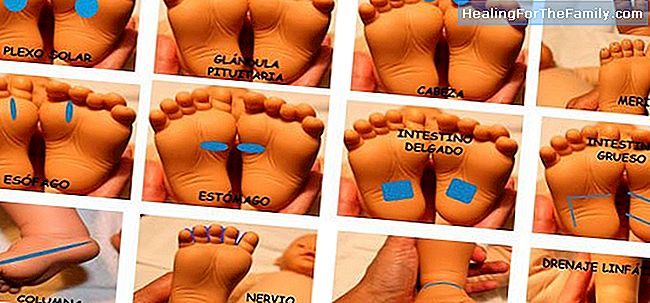How to relieve with reflexology the colic of the infant
Infant colic is a very frequent problem in pediatric consultations. It is usually diagnosed in 15-40% of children in the first three months of life, regardless of the type of breastfeeding with which they are fed, maternal or artificial. Tends to occur in infants with a sensitive temperament and les
Infant colic is a very frequent problem in pediatric consultations. It is usually diagnosed in 15-40% of children in the first three months of life, regardless of the type of breastfeeding with which they are fed, maternal or artificial.
Tends to occur in infants with a sensitive temperament and less need for sleep than usual. The baby can cry at times or almost all the time and at the end of the afternoon they are usually extremely irritable, but could give them colic at any time of the day.
Possible causes of infant colic

As parents, this specific problem will generate great anxiety and worry due to crying, but remember that it is a benign process that will resolve spontaneously around four months, leaving no type of sequels to the baby.
Much has been said about the causes and many are the research work related to colic, but the reality is that currently the exact cause of infant colicis unknown. The digestive causes presented by children seem to be related to the immaturity of the intestine of the newborn, there may be allergy to cow's milk proteins, hypermotility, gases and something that we should never rule out, psychological causes. Our attitudes and thoughts, along with our stress and anxiety are perceived by our baby.
Common symptoms of infant colic
Your pediatrician will be best suited to diagnose your baby's colic, but here is a list of the most common symptoms
- Crying inconsolable crisis, frowns and often get very red by crying
- The baby stiffens, is restless, irritated, upset, agitated; seems to be hungry but does not calm down with food or chest
- Flexes the legs on the abdomen and has a bulging in the gut by accumulation of gas in the intestine.
- Milk regurgitation, constipation or colitis may occur
Tips for relieving infant colic

The practice of reflexology in infants requires special attention. Manipulations should be more subtle and smooth than in an adult. This is because the baby will have pain in the reflexes that represent the digestive system in the foot, especially in the large intestine and small intestine, and will not allow us to touch him if we hurt him. Therefore, the movements should be accurate and energetic but gentle and the pressure will gradually increase.
The position to give the technique of reflexology will be the most comfortable for the baby and for those who perform the massage, in the case of foot reflexology, we will look for the position that allows us to see the sole of the baby's feet. Lying on our knees when its size is not yet very large is one of the favorites and lying on the bed or in the armchair, it is the one chosen when its length no longer allows us the previous position, but above all and the most important is the comfort of who is going to perform the massage. We must be relaxed, comfortable and with the feeling that time will stop during the massage. We will talk to the baby while we work with him, using a warm and affectionate voice. Remember that for the adult to support the back on something stable that keeps it straight helps to be relaxed and not in tension.
The frequency to perform the technique in cases of colic will be daily trying to avoid the moment of crisis. The reason is to move forward to avoid it, but if we had to do it in the moment of crisis, it could be done without any fear. But remember, if the technique is well applied, the relief of colic symptoms will be evident from the first day.
The reflex zones to be treated are: Solar Plexus, Pituitary Gland, Head, Meridians, Esophagus, Stomach, Small Intestine, Large Intestine, Vagus Nerve Column, Lymphatic Ganglia, Lymphatic Drainage.












